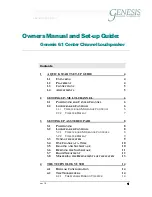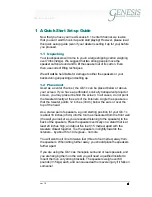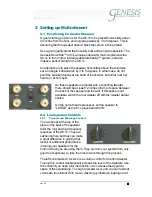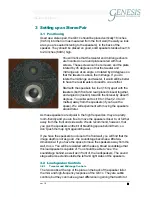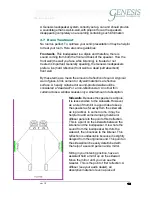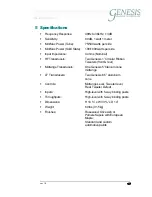
ver 1.0
10
10
10
10
~ÄëçäìíÉ=ÑáÇÉäáíó
position, they may not sound perfect, but your Genesis loudspeakers will
sound great straight out of the box.
3.4 One Change at a Time
One rule of thumb you should always keep in mind: Make one change
at a time! Do not, for instance, change position of the speakers and
make an adjustment to the amplifier all at once. Make each of these
changes separately and note the difference - by listening with each
adjustment - then make the next change.
3.5 Imaging and Soundstage
We suggest that you start with a single vocal with simple instrumental
accompaniment because the sound of the human voice is more easily
recognizable than many instruments and is a less complex sound to
deal with. Use a good recording that you know has atmosphere and
low bass content.
The performer should appear to be positioned behind the loudspeakers
and be at the appropriate height for a standing person. If it is not, there
are several remedies that will address this shortfall:
If the vocal appears to be larger than life, you should first check the
system volume. Is it a volume that would be appropriate for
someone actually singing in your room? If there is too much volume
the artist will appear too big and the opposite is true for too little
volume. If the volume is set correctly and the image is still too big,
place the speakers closer together and re-listen. Place the speakers
no less than 5 feet apart. If the image is still too big, toe the
speakers in a slight amount.
Conversely, if the image is too small, move the speakers apart. The
speakers should be no more than eight feet apart. Repeat this process
until you have it right. If the voice is too low in height, turn the
MIDRANGE control up (turning the knob clockwise), and the image of
the voice will move upward slightly.
If you have the speakers 18 inches into the room, and you are not
getting enough front to back depth (the singer not appearing behind the
speaker enough), pull the speakers away from the front wall a little bit at
a time. If you do not have them pulled far enough away, you may
not have enough front to back depth. However, slightly more than
1/3 of the way into the room is about as far as you want to go.
Pulling them half-way into the middle of the room is unlikely to help.

